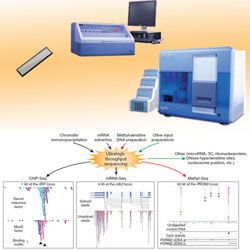Sequencing
|
Contents
[hide]Technology
The GTC offers Next-Generation sequencing on the Illumina platform. We have two GAII systems and one HiSeq2000. The GAII systems typically yield 10-30 million reads per lane in single read or paired end mode. The HiSeq2000 typically yields 70-100 million reads per lane for only about 50% higher costs. Further costs savings can be realized with sample multiplexing.
Library Prep Services
We offer three full service options for library prep each using the Illumina TruSeq system with up to 12 unique barcodes for multiplexing. The Manual library prep protocol yields the highest quality libraries and is compatible with low sample inputs for applications like ChIP-seq. The SPRIworks protocol uses the SPRIworks system from Beckman for high-throughput processing and is appropriate for preparing libraries from high quality and quantity DNA inputs. The RNA-seq protocol is a manual protocol starting from total RNA and uses the Illumina TruSeq RNA kit.
Pricing
For pricing information - Click Here
Sample Submission Guidelines
Please use our sample submission forms found here. Internal users should use the online form, external users should download the excel form.
Users may submit fully prepared libraries with Illumina adapters or dsDNA or total RNA for our library prep services.
User prepared libraries should be gel-purified and provided UNDILUTED in EB or similar. Please submit 5uL of undiluted sample. We will determine the concentration by RT-PCR and make the appropriate dilutions. Excess sample will be retained in our freezers for potential future re-run. Users are also strongly encouraged to retain a portion of their samples in case of emergency.
For the library prep service please submit dsDNA for the standard protocols or total RNA for the RNA-seq protocol. We will provide all reagents for adapter ligation and enrichment. There is a wide range of suitable volumes and concentrations but we will need to know approximate values.
GTC will provide sequencing primers for libraries prepared with standard Illumina adapters. If custom sequencing primers are required they must be provided at the time of sample submission.
Data
Images acquired from the sequencer are processed through the bundled Illumina image extraction pipeline to get the sequence and quality score for each base. If requested, the reads can be aligned to a reference genome using the Illumina ELAND algorithm. An in-depth QC report is included in the package.
- QC Details - Sequencing
- Formats Details - Sequencing
Turnaround Time
Each sequencer processes 8 samples per run, or 7 samples plus a control. Full flowcell submissions (7 samples) can usually be started within one week of submission. Partial submissions of less than seven samples are put into a project queue where they join existing samples or await others before processing. Wait times for partial submissions vary but are generally two weeks or less until the START of the run depending on the requested run configuration and demand from other users. The most common run configuration is short (40 bases) and single read. Longer read and paired-end samples may take longer to turn around as there are generally fewer similar samples in the queue to fill out runs. Once a run has started, estimate approximately 1 day per 20 bases for the run and an additional 24-48 hours for data processing. Samples requiring library prep will also take an additional approximately one week for the prep.
Applications
Next-Generation Sequencing can be used for a wide variety of applications including ChIP-Seq, RNA-Seq, smallRNA-seq, GWAS and much more. Visit Illumina's web site or contact us to discuss your project goals.
